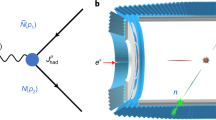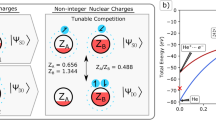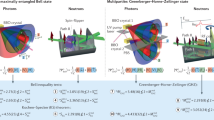Abstract
IT is known that, starting with Fermi's expression for the coupling between a heavy nuclear particle and the field of electrons and neutrinos, we get in the second approximation the law for interaction between proton and neutron1. This law: (g is Fermi's constant, the best choice for s is 3) gives a divergent result at r 0, which shows the impossibility of constructing a point model of a heavy particle, just as the classical and quantum electrodynamics both lead to infinite self-interaction of a point charged particle on Coulomb's formula. The only reasonable method so far proposed to remove this difficulty of classical electrodynamics is the nonlinear generalization of Maxwell's equations developed by Mie and Born2, who introduced a new characteristic length (the analogue of the radius of the electron).
This is a preview of subscription content, access via your institution
Access options
Subscribe to this journal
Receive 51 print issues and online access
$199.00 per year
only $3.90 per issue
Buy this article
- Purchase on SpringerLink
- Instant access to full article PDF
Prices may be subject to local taxes which are calculated during checkout
Similar content being viewed by others
References
D. Iwanenko and A. Sokolow, Verhandl. d. Sibirisch, Phys.-Techn. Instituts, (Russ.), 4, 67 (1936). NATURE, 138, 246 (1936). Z. Phys., 102, 119 (1936).
M. Born, Proc. Roy. Soc., A, 143, 410 (1934).
W. Heisenberg, Z. Phys., 101, 119 (1936).
Author information
Authors and Affiliations
Rights and permissions
About this article
Cite this article
IWANENKO, D., SOKOLOW, A. Self-Interaction of Neutrons and Protons. Nature 138, 684 (1936). https://doi.org/10.1038/138684a0
Issue date:
DOI: https://doi.org/10.1038/138684a0
This article is cited by
-
Kernkr�fte
Die Naturwissenschaften (1937)



